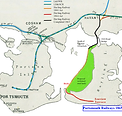
EARLY HISTORY
This section describes the demand for good transport links in the area and the reason why the Hayling Branch Line became important. It then follows the struggles to establish the branch line.

1864 Map of Hayling Island
This map shows the rural nature of Hayling Island and the new housing developments on the east of the Island. It also shows the original route of the Hayling railway as authorised by the 1860 Act of Parliament, running on an embankment to the proposed docks near the Portsmouth – Hayling Ferry. The 1864 Act [...] Read more..
Frederick Furniss 1825 - 1891. Contractor for the Havant to Hayling Branch Line
In July 1860 the Hayling Railway Company was formed, in order to build a branch line from Havant to South Hayling. It was estimated that it would take seven years to raise the money, acquire the necessary land and build the line. The civil engineer contracted to build the line was Frederick Furniss, who was [...]

A change of direction under Francis Fuller
The political climate had changed and as a result, the drive to create satellites to the Port of London had diminished. The objective of creating a goods railway onto Hayling had sunk with the crumbling embankments. It really seemed that the Hayling venture was a complete failure. A change of direction was needed if the [...]Read more..

1864 Act of Parliament
1864 Act of Parliament Construction of the railway as defined in the 1860 Act was slow and had not started in 1862 leading to a notice being placed in the London Gazette, 26 November 1862, that an application to abandon the railway and dissolve the Company was to be made. Work did start mid 1863 [...]Read more..

1859 Proposed Bill to Parliament and 1860 Act of Parliament
Proposed Bill A notice was published in the the November 25th 1859 London Gazette advising of the intention to bring a Bill before parliament to form a Company, working with the L&SWR, the LB&SCR and The Portsmouth Railway to create merchant docks, connected by railway, as described in the 1855 proposal in the Nautical Magazine. [...]Read more..

Arrival of the Portsmouth Direct Line 1857
In the winter of 1857/8, the Portsmouth Company’s railway line between Godalming and Havant was connected to the London Brighton & South Coast Railway LB&SCR) at Havant. This provided a much shorter route to London via Guildford. Incredibly, running rights over the LB&SCR to Portcreek Junction had not yet been agreed and thus left the new [...]Read more..
The Political scene 1850's - 1870
The confidence in our ability to trade freely around the world following the 1815 British victory at Waterloo was badly shaken in the late 1850s. France once more posed a threat under Napoleon III with her renewed territorial ambitions. Shipping through the English Channel, to reach the Port of London, was once more considered to [...]Read more..

1855 Proposal for a Railway linking Havant to Hayling Island
Introduction of Railways provided great opportunities to improve connections throughout Britain but steam vessels introduced a new and deadly threat our commercial trade at time of war, in particular, to ships travelling through the narrow seas of the English Channel, to reach the Port of London. A paper was published in the 1855 Naval Chronicle, which [...]Read more..

Railway Connections in 1850
The introduction of the railway at Havant presented two routes to London; east via the London Brighton and South Coast Railway (LB&SCR) to London Bridge or west via the London & South Western Railway (L&SWR) to Waterloo. Although the railway routes were longer they provided a quicker and more comfortable way to travel to the [...]Read more..